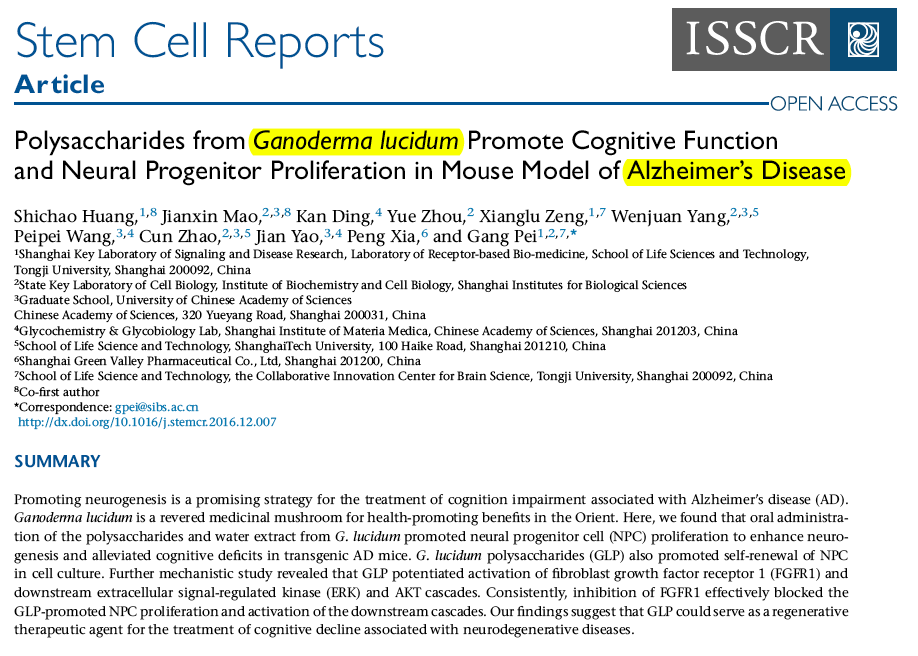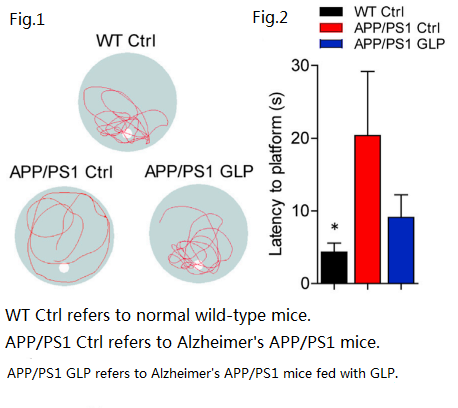1月 10, 2017 /同済大学, 上海マテリアメディカ研究所, 中国科学院, 等. / 幹細胞レポート
文/呉廷耀

「自分が何者であるか、私が何者であるかを忘れる」は、アルツハイマー病の最も典型的な症状と言えます。. 忘れる理由, または最近の出来事を思い出せない, それは、認知機能をつかさどる神経細胞が年月とともに少しずつ死んでいくということです。, それは大人の認知レベルを退化させ続けます.
ますます蔓延するアルツハイマー病に直面する, 科学者たちは実現可能な治療法の研究に熱心に取り組んでいます. 神経細胞死を引き起こす犯人に焦点を当てる人もいます, ベータアミロイドタンパク質の生成を減らそうとする; 神経細胞の再生促進に取り組んでいる人もいます, 神経細胞の損傷による欠損を補うことを期待している, それは「足りないものを補う」という考え方なのかもしれない。
成熟した哺乳類の脳内, 新しい神経細胞を生成し続ける領域が確かに 2 つあります, そのうちの1つは海馬回にあります. この自己増殖する神経細胞を「神経前駆細胞」といいます。. そこから新しく生まれた細胞は元の神経回路に追加され、新しいスキルの学習や新しい記憶の形成に役立ちます.
しかし, アルツハイマー病が神経前駆細胞の増殖を妨害する可能性があることは、ヒトまたはマウスで観察できます。. 最近では, 神経前駆細胞の増殖を促進すると、アルツハイマー病によって引き起こされる認知機能の低下を軽減できる可能性があり、アルツハイマー病の治療に実行可能な戦略となる可能性があることを示す証拠が増えています。.
1月に 2017, 同済大学が「Stem Cell Reports」に共同発表した研究, 上海生物科学研究所, 中国科学院, 等, から多糖類または水が抽出されることを証明しました。 マンネンタケ(霊芝, 霊芝) アルツハイマー病によって引き起こされる認知障害を軽減できる, アミロイドβの沈着を減らす (Aβ) 脳の中で, 海馬回の神経前駆細胞の再生を促進します。. 後者の作用機序は、神経前駆細胞上の FGFR1 と呼ばれる受容体の活性化に関連していると考えられます。 マンネンタケ.
食べるアルツハイマー病のマウスマンネンタケ 記憶力が良くなる.
この研究での動物実験では、 5 生後6か月のAPP/PS1トランスジェニックマウスに、つまり, 遺伝子導入技術を利用して変異型ヒト遺伝子APPおよびPS1を導入する (遺伝性の若年性アルツハイマー病を誘発する可能性がある) 遺伝子を効果的に発現させるために、生まれたばかりのマウスに注入します。. これにより、マウスの脳がアミロイドβを生成し始める (Aβ) 若い頃から (後 2 月齢), そして彼らが成長したとき 5-6 月齢, 徐々に空間認識や記憶に困難が生じます。.
言い換えると, 実験に使われたマウスにはすでにアルツハイマー病の初期症状があった. 研究者らはそのようなアルツハイマー病マウスにGLPを与えた (から分離された純粋な多糖類マンネンタケ 分子量が の胞子粉末 15 kD) 1日あたりの用量で 30 mg/kg (つまり, 30 1日あたり体重1kgあたりmg) のために 90 連続した日々.
それから, 研究者たちはさらに費やした 12 モリス水迷路でマウスの認知能力をテストする日々 (MWM) そして、治療を受けていないアルツハイマー病のマウスのマウスと正常なマウスのマウスのマウスのマウスのマウスと比較した。.
ネズミは生来水を嫌う性質を持っています. 水に入れると, 彼らは乾いた休息場所を見つけようとするだろう. 「モリス水迷路テスト」は、その性質を利用し、大きな円形プールの一定の場所に休憩台を設置します。. プラットホームは水面下に隠れているので、, ネズミは学習して記憶することによってのみそれを見つけなければなりません. 結果として, 研究者らは、マウスがプラットフォームを見つけるまでにマウスがバカになったか賢くなったかを判断できるようになった, 彼らが泳いだ距離と彼らが通った道.
各グループのマウスの水泳速度に有意な差がないことが判明した. ただし、通常のマウスと比較すると、, 何も治療を受けていないアルツハイマー病マウスは、まるで幸運だったかのように、乱れた道に沿って乗り場を見つけるために、より多くの時間を費やし、より長い距離を泳ぐ必要がありました。, 彼らの空間記憶が著しく損なわれていることを示しています.
対照的に, アルツハイマー病マウスに餌を与えた 霊芝 多糖類や マンネンタケ 水抽出はプラットフォームをより速く見つけました, そしてプラットフォームを見つける前に, 彼らは主にその地域を歩き回っていました (象限) プラットフォームがあった場所, まるでプラットフォームのおおよその位置を知っているかのように, 脳への損傷がそれほど深刻ではないことを示しています. 【形 1, 【図2】
加えて, 研究者らはまた、別の実験で、ショウジョウバエがアミロイドβを大量に生成することを観察した。 (Aβ) 彼らの脳内で (実験モデルを確立するための遺伝子導入法も使用), マンネンタケ 水抽出物はショウジョウバエの空間認識能力と記憶能力を向上させるだけでなく、ショウジョウバエの寿命を延ばすこともできます。.
研究者らも使用したマンネンタケ 水抽出物 (3001日あたりmg/kg) 前述の動物実験で、前述と同様にアルツハイマー病による空間認知障害を軽減できることが判明しました。マンネンタケ 多糖類 (GLP).

「モリス水迷路テスト」を使用してマウスの空間記憶能力を評価する
[形 1] 各グループのマウスの遊泳経路. 青いのはプールです, 白い部分はプラットフォームの位置です, そして赤いのが遊泳路です.
[形 2] モリス水迷路試験の 7 日目にマウスの各グループが休憩台を見つけるのに必要な平均時間
(ソース/幹細胞レポート. 2017 1月 10;8(1):84-94.)
霊芝 海馬回における神経前駆細胞の増殖を促進します。.
12日間の水迷路試験後, 研究者らがマウスの脳を分析したところ、マンネンタケ 多糖類とマンネンタケ 水抽出物は海馬回の神経細胞の再生を促進し、アミロイドβの沈着を減少させます。.
さらに、海馬回で新しく生まれる神経細胞は主に神経前駆細胞であることが確認されました。そしてマンネンタケ アルツハイマー病マウスに効果がある. 正常な若い成体マウスに以下の餌を与えるマンネンタケ 多糖類(GLP) 1日あたりの用量で 30 mg/kg 14 また、海馬回における神経前駆細胞の増殖を促進する可能性もあります。.
インビトロ実験でも、正常な成体マウスやアルツハイマー病マウスの海馬回から単離された神経前駆細胞、あるいはヒト幹細胞由来の神経前駆細胞について、, マンネンタケ 多糖類はこれらの前駆細胞の増殖を効果的に促進します。, 新しく生成された細胞は神経前駆細胞の元の特性を保持します。, つまり, 彼らは増殖と自己再生を行うことができます.
さらなる分析により、マンネンタケ 多糖類 (GLP) 主に「FGFR1」と呼ばれる受容体を強化できるため、神経新生を促進できます。 (EGFR受容体ではありません) 神経前駆細胞について, 「神経成長因子bFGF」の刺激を受けやすくなります。, 「細胞増殖」に関するより多くの情報を神経前駆細胞に送ります。, そしてさらに新しい神経細胞が生まれます.
新しく生まれた神経細胞は、必要な脳領域に移動した後、既存の神経回路にさらに結合して機能することができるため、, これにより、アルツハイマー病における神経細胞死によって引き起こされるさまざまな認知障害が軽減されるはずです.
多面的な役割マンネンタケ 忘れる速度を遅くする.
上記の研究結果により、次のような保護効果がわかります。マンネンタケ 神経細胞に. 抗炎症作用に加えて、, 抗酸化物質, 抗アポトーシス, 抗βアミロイド沈着および過去に知られているその他の効果, 霊芝明晰 神経新生を促進することもできます. 同じ遺伝的欠陥を持ち、同じ症状を呈するアルツハイマー病マウスの場合, これが、食事をする人の間で病気の症状の重症度が大きく異なる理由です。マンネンタケ そして食べない人もマンネンタケ.
マンネンタケ アルツハイマー病患者の記憶機能を完全に回復できない可能性がある, しかし、そのさまざまな作用機序によりアルツハイマー病の悪化を遅らせることができます。. 患者が自分と他人のことを生涯覚えている限り, アルツハイマー病はそれほどひどいものではないかもしれない.
[ソース] 黄 S, 他. 霊芝由来の多糖類はアルツハイマー病のマウスモデルにおける認知機能と神経前駆細胞の増殖を促進します. 幹細胞レポート. 2017 1月 10;8(1):84-94. 土肥: 10.1016/j.stemcr.2016.12.007.
終わり
著者について/Mさん. 呉廷耀
ウー・ティンヤオ氏は、以来、霊芝に関する直接の情報を報告し続けている。 1999. 彼女はの著者です霊芝による治癒 (4月に人民医学出版社に出版 2017).
★この記事は著者の独占的な許可を得て掲載されています.
★上記作品は転載禁止です, 著者の許可なく抜粋または他の方法で使用される.
★上記記載事項に違反した場合, 著者は関連する法的責任を追及します.
★この記事の原文はWu Tingyaoが中国語で執筆し、Alfred Liuが英語に翻訳しました。. 翻訳に齟齬があった場合 (英語) そしてオリジナル (中国語), 本来の中国人が勝つだろう. 読者に質問がある場合, 原作者に連絡してください, MS. 呉廷耀.



